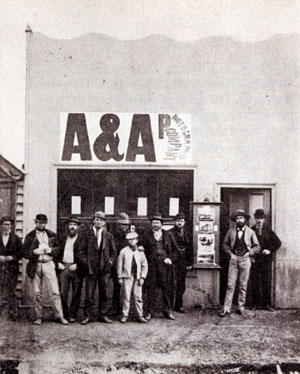The
American and Australasian Photographic Company
is recognised as the company
established by Beaufoy Merlin in Melbourne in the mid
1860s. They also used the title: American and Australian Photographic Company.
The
accounts usually state that Merlin operated under this
international title with no evidence of
any connection beyond Australia. However, Merlin indicated that the A&A had offices in San Francisco and New york on the back of his CDVs - not evidence of these offices has surfaced. No doubt this American connection added prestige to his company's profile.
It was into this
company that Merlin ushered in Charles Bayliss to be
his assistant
as they travelled throughout Melbourne and the Victorian
towns to photograph every building.
In
1870, Merlin moved to Sydney with Bayliss now entrusted
with the Melbourne operation. In 1872, Merlin moved
to the NSW goldfields around Hill End and Gulogong
with a shop front in Hill End with the company
name above the door.
While the majority of
statements about Bayliss during this period refer to
him as Merlin's assistant and place him alongside Merlin
in the NSW goldfields. There is evidence that just maybe
Bayliss spent more of his time in Melbourne managing
the A&A studio or even out working as a travelling photographer.
So while Bayliss is definitely recorded as being with
Merlin at times in the NSW goldfields, the speculation
is that maybe he was not there full time, but rather
on visits from their Melbourne studio.
The majority of studio
photos in Hill End and Gulgong, while taken under the
directorship of Merlin (or Bayliss) as the A&A Photographic
Co, it is most likely that this day to day work was done
by the studio manager, Clark. Whereas it is most likely
that the house to house (and business and events) photos
were taken by Merlin with the assistance of his driver/assistant
(seen standing behind Bayliss below).

After
Merlin's death in late 1873, the American and Australasian
Photographic Company fades
from view. Bayliss took over the commission for Holtermann,
but the rest of the studio and its photographs and
negatives seem not to have been taken over by Bayliss.
He instead went to work on Holtermann's commission
till around 1876 when he established himself in Sydney
under his own name.
In
1951, Keast Burke was introduced to a well preserved
but ignored photographic
collection in the garden room of one Mrs Holtermann.
this is the collection, now in the Mitchell Library
(Sydney) which has now been called the 'Holtermann
Collection'. In fact much of the work pre-dates Holtermann's
commission and is the work of the American and Australasian
Photographic Company. One can surmise that B O Holtermann
must have taken possession of the studio's contents
after Merlin's death.
The
story above is pretty much as largely reported, but
now to open up a few more queries.
There
is some speculation that he may have learnt his photographic
trade through a
photographer, possibly a relative, T Merlin of Ballarat.
His own father had been a chemist, and this could
have also been an influence given the then close link
between
chemical sciences, with almost all chemist dabbling
in the new art of photography. Maybe he learnt his new trade in London when he returned and married. All this is of course
speculation, well informed, but it remains speculation.
So
the question is was there in fact an American connection?
Did he travel back to California, something quite
easy to do given the shipping routes of the day and
the
attraction of people to gold rushes on both sides
of the Pacific. Or did someone from California form part
of the Melbourne operation of the American and Australasian
Photographic Company ?
Of
interest to the history of this company are entries
in Sandy Barrie's seminal work in putting dates on
the movement of Australian photographers. Sandy has
the first entry as: Melbourne
(73 Little Collins) 1869-1870. This matches the entries
for Merlin, which have him operating around Victoria
from 1865 to 1870, and for Charles Bayliss for the
period 1870-1873. However, the more interesting information
is that another photographer, James
P Lind while operating
in Melbourne from 1866, is identified by Barrie as
being the American and Australian
Photographic Company from 1872-1876, this overlapping
with Bayliss's time with the Victorian branch of the
American and Australasian
Photographic Company.
Then
there's the Queensland Branch. Sandy Barrie has
a photographer, named Edward H Forster, operating under
the title the American and Australasian
Photographic Company, Queensland branch from the mid
1860s.
What
was the connections here? Remember that Merlin travelled along the same Queensland coast in 1870 so may have met up with the local photographers. And Bayliss is reported to have taken a journey later to the same region.
Researchers have made the connection that maybe Merlin saw the
opportunity for expansion of the American and Australasian
Photographic Company into
Queensland when he passed through the South East of
Queensland on
his boat trip to the north in 1871.
The other 'coincidence'
is that Forster married in Sydney in 1871 then moved
back to Maryborough and opened the studio for the American
and Australasian Photographic Company, named the American
and Australian Photographic Company.
All
the while, tehre was also a similarity
in the style of photography as being practiced by Merlin,
Lind and Forster, to be later expanded by Bayliss.
Evidence
points to some form of east coast network of entrepreneurs
and photographers. In this context, the linking of
Merlin's craft with Holtermann's ambitions makes more
sense.
For
the
moment, we await further research and possible
information..
by
all means make contact:
<< Return to the introduction